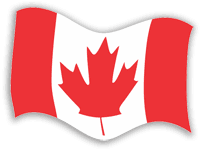
 #34
Quebec: Heart of French Canada
#34
Quebec: Heart of French Canada
by P. E. Bryden
|
Quebec is Canada’s oldest province. The French explorer Samuel
de Champlain established the first continuous permanent
settlement in North America in 1608 on the shores of the St.
Lawrence River at what would become known as Quebec City. The
area had already long been inhabited by Iroquois and Algonquin
First Nations, and further north by Inuit, but with Champlain’s
settlement the French staked a claim to Quebec. Controlling the territory proved much more difficult than planting the flag. Early Europeans in Quebec were interested in commerce — searching for gold, a trade route to China and, finally, and more successfully, engaging in the trade of furs between North America and Europe. They were also interested in saving souls, regarding the First Nations inhabitants of Quebec who they saw as godless and in need of Christianity. But English settlers were rapidly migrating to North America as well, interested in all the same things as the French, and the two empires became locked in a constant battle for control of the continent. The struggle between the French and the English culminated in the Seven Years War, a global conflict fought by the two European countries, their allies, and their various colonies around the world between 1756 and 1763. In North America, the French in Quebec were initially quite successful in fighting the English, but in the end they lost the Battle of the Plains of Abraham in Quebec in 1759. This defeat, known in Canada as the conquest, and while hardly pivotal in the Seven Years War, nevertheless marked the end of French control of Quebec. English government supplanted French rule, but Quebec remained a predominantly French colony — of Britain, now, rather than France. It had a largely agricultural economy, although the large urban communities of Montreal and Quebec City thrived as centres of commerce, education and finance, where the English tended to dominate. The awkwardness and unfairness of a colony in which the majority were French-speaking, but the political and industrial elites were English-speaking led to a small, short-lived rebellion in the 1830s. It also suggested to the British that Quebec should be united with the English-speaking colony of Upper Canada to the west in the hopes that the French would slowly assimilate to the dominant English culture. That was a foolish proposition. The union of the two colonies, one French and one English, proved not to work. The solution was to separate into the original two colonies, Quebec and Ontario, and unite with other British North American colonies as the new nation of Canada. Quebec has remained primarily French-speaking. Political and cultural leaders have cultivated the French-Canadian nationalism that has stemmed from this distinctive characteristic of Quebec. Sometimes, this has meant that Quebec seems particularly insular, more interested in what goes on within the province that in being a part of Canada. Superficially, Quebec seemed to remain a very rural, very traditional society throughout the first half of the 20th century. In the 1960s Premier Jean Lesage undertook major modernization projects — taking over the delivery of hydro electric power, introducing a new education system, and revitalizing the financial institutions — as part of a new French-Canadian nationalism. The Quiet Revolution, as the process of modernization became known, established Quebec as a modern French-speaking state within Canada. But modernization was not enough for many people. By the end of the 1960s, separation from the rest of Canada had become a goal for many of Quebec’s leaders. René Lévesque, the founder of the Parti Québécois, was elected as Canada’s first separatist premier in 1976, committed to exploring the possibility of an independent Quebec nation. Lévesque was followed by other separatist premiers, but none have so far been successful in pulling Quebec out of Canada. Two referenda, one in 1980 and one in 1995, asked Quebeckers whether they were prepared to separate, and in both cases the answer was no — although it was a pretty weak no in 1995. The process of modernizing the Quebec state has sometimes come at the expense of the rights and hopes of others living within Quebec. The French struggle for independence, for example, has often come in conflict with the efforts of First Nations to secure land. The stand-off at Oka in 1990, during which Mohawk warriors prohibited non-natives from using highways that crossed their territory, was one of the most violent confrontations between the Quebec state and the First Nations it was displacing. Similarly, the goals of immigrants who are seeking to become Canadians rather than Québécois have often been represented as contrary to the objectives of the Quebec government. Just as Quebec premiers have worked with various degrees of enthusiasm to secure an independent nation, Canadian prime ministers from Lester Pearson and Pierre Trudeau through to Brian Mulroney and Jean Chrétien have fought to keep the country whole. In Canada, the struggle between French and English that began in the 17th century continues through to the present. Next Instalment: The West The Canadian Experience is a 52-week history series designed to tell the story of our country to all Canadians. Sponsored by Multimedia Nova Corporation and Diversity Media Services partners, the series features articles by our country’s foremost historians on a wide range of topics. Past articles and author bios are available at http://www.cdnexperience.ca. The Canadian Experience is copyright ©2010-2011 Multimedia Nova Corporation. |
List of published "Canadian Experience" articles |
The Canadian Experience communicates to
us about the many facets of Canada, the people, the Charter, brings us
reality and creates understanding.
Copyright ©2010 Echoworld Communications. All rights
reserved

